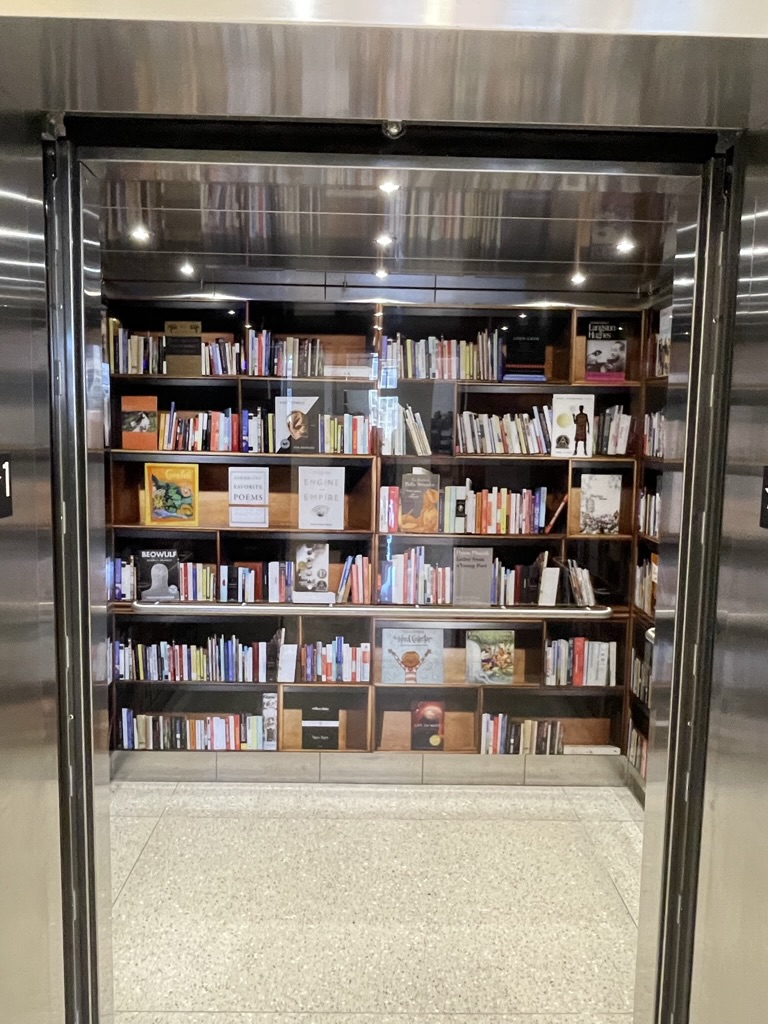My linguistic challenge at the moment is expressing my ecstasy, relief, and admiration after visiting Planet Word, founded in May 2020, in Washington, D.C. “Planet Word” sounds like more fun than “Planet Linguistics,” but what you learn there is more than words.
At the entrance is a sculpture made of metal rendering of the letters of our alphabet. Planet Letter. A mere gaze reveals how varied and interesting the letters of our alphabet are. They have a certain clear, practical personality. It also reminds that there are many other alphabets, all of which could be just as beautifully rendered.
The restroom wall is festooned with the word “toilet” in amazing alphabets. Some are flowing, some seem to have a line along the top of the letters, some along the bottom some go right to left, our left to right.
| Bathroom | English |
| mayllikuna wasi | Quechua |
| دوره المياه | Arabic |
| حمام | Persian |
| adwareɛ | Akan |
បន្ទប់ទឹក | Khmer |
| トイレ | Japanese |
浴室 | Chinese |
| Ванна | Kyrgyz |
Ready to go, my daughter and I headed to the elevator which would take us to the third floor. The elevator door opened into a bright, magical library, lined floor to ceiling with books. Already, we were in a different world.

The large hall on the third floor featured a hanging mirror ball and a couple of dozen video stations spaced around it. Each stand featured a person introducing their native language, a few “fun facts” and a snippet of the language. I learned that Navajo has a sound not used in any other language and that the Portuguese language differs when spoken in Brazil and Portugal. I was reminded that Quechua is spoken by millions of people in South America.
We next entered a wall to ceiling “library,” with displays of real books and hundreds of book facsimiles similar to the ones in the elevator. We listened through earphones to selections from a real book on a shelf before us, reminding us of the pleasure and relaxation of being read to. The books chosen for this experience represented modern and vintage books from a cross section of American culture.
Another room had a sculpture on the wall made up of words in different sizes. Here we learned how the English language was created. As the narrator introduced each contributor (Latin, French, German, and others) words were highlighted on the wall, giving a clear idea of how much of our language had come from that other language. I was sorry they stopped with only the greatest contributors—I’d wanted them, for example, to tell us that one of our favorite words ketchup most likely comes from the Chinese Hokkein dialect, and many of our place names, such as Hoboken, Chesapeake, Tuscaloosa, Illinois, Massachusetts, and so on, come from indigenous languages. Languages update themselves with slang and other inventions, and I was surprised to learn that the largest percentage of newly created words come from teenage girls.
By this time, we were approaching overload, but the children were still energized and ready for their next adventure. They inspired us to continue.
What could do in the karaoke room? Was this going to be an exercise where songs were sung by awkward humans? No. It showed how metaphor was used to tell a story. The song was one I’d never heard of, Firework. The phrase explained was “You’re a firework,” a metaphor. The voiceover explained that if the lyrics were “You’re like a firework,” it would be a simile. And then they played the song. After a while, one gangly, pre-teen girl got up and shyly started singing. I could barely hear her. Soon there were four more gangly pre-teens singing their hearts out. It is unlikely they will ever forget that “You’re a firework/the bomb/a horse of a different color” are metaphors.
By this time I was over the moon. Kids and their parents were beaming, eager to learn from exhibits that invited their participation and choice, teaching them by binding emotional enthusiasm to the museum’s exhibits.
One last room, for us anyway, introduced concepts such as “word play,” and “double meaning.” They used familiar advertising slogans to illustrate. What method did the creator use to catch your interest? Below are some examples, not from the museum (I didn’t bring a notebook. I should have.) but you’ll get the point.
Amazon/Amazoff, showing a thick forest on one side, a denuded plain on the other
You’re in good hands with Allstate
Snickers: Hail the Snaxi! With a picture of a taxi
Krazy Glue
As I washed my hands before lunch at the restaurant next door, I looked at the dancing alphabets displayed on the restroom walls with different eyes. Each held within it a sound and rhythm, a history, a culture, and a population that spoke it.
The Planet Word museum was richer than Alice’s rabbithole and just as entertaining.
